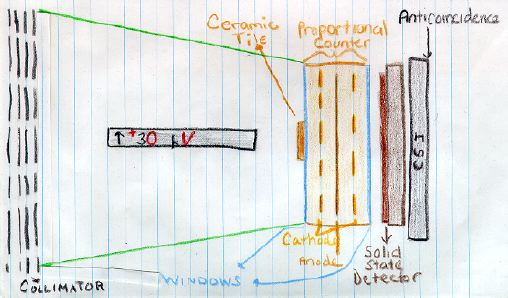
How SEPICA Works
SEPICA is designed to identify particles through a series of measurements taken as they pass through the instrument.

Particles enter through the collimator, after which they are headed to the same point on the solid state detector (SSD). However, some are deflected by the positively charged center plate. Particles with a positive charge, having lost some electrons in space, are deflected, while neutral particles remain true to their original path. Each particle has its own energy per charge ratio. The greater the ratio, the less it is deflected by the center plate.
Next, the particles enter the proportional counter (PC), which is full of iso-butane gas. The purpose of the PC is to measure the energy per charge ratio. Electrons from the particles are used to ionize the gas. The electrons are attracted to the annode, while the positively charged ions are attracted to the two cathodes.
The particles then move to the SSD, which maps their impact point and measures any energy remaining. The SSD consists of 19 pixels.
![]()
If the particle has too much mass and energy for SEPICA to measure, it will fly through the machine and exit through the anticoincidence, which is full of CsI gas. The purpose of the anticoincidence is to distinguish between good information and bad information. Measurements from particles that exit the instrument are useless because not all the energy has been measured, therefore no identification can take place.
The instrument can be calibrated while in space by the use of calibration alphas. These alphas are located in the instrument. They are set to show up on the graph printouts at a certain spot, far away from other results. When they show up at the right place (710 on the high gain), we know the instrument is operating properly.
Didn't understand this?? Take a trip through our SEPICA jungle !!!